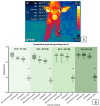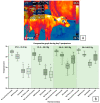Strategies and Mechanisms of Thermal Compensation in Newborn Water Buffaloes
- PMID: 37443964
- PMCID: PMC10340076
- DOI: 10.3390/ani13132161
Strategies and Mechanisms of Thermal Compensation in Newborn Water Buffaloes
Abstract
Hypothermia is one of the principal causes of perinatal mortality in water buffaloes and can range from 3% to 17.9%. In ruminants, factors affecting hypothermia in newborns may be of intrinsic (e.g., level of neurodevelopment, birth weight, vitality score, amount of brown fat, skin features) or extrinsic origin (e.g., maternal care, environmental conditions, colostrum consumption). When newborn buffaloes are exposed to cold stress, thermoregulatory mechanisms such as peripheral vasoconstriction and shivering and non-shivering thermogenesis are activated to prevent hypothermia. Due to the properties of infrared thermography (IRT), as a technique that detects vasomotor changes triggered by a reduction in body temperature, evaluating the central and peripheral regions in newborn buffaloes is possible. This review aims to analyze behavioral, physiological, and morphological strategies and colostrum consumption as thermal compensation mechanisms in newborn water buffalo to cope with environmental changes affecting thermoneutrality. In addition, the importance of monitoring by IRT to identify hypothermia states will be highlighted. Going deeper into these topics related to the water buffalo is essential because, in recent years, this species has become more popular and is being bred in more geographic areas.
Keywords: Bubalus bubalis; non-shivering thermogenesis; ruminant hypothermia; shivering thermogenesis; thermoregulation.
Conflict of interest statement
The authors declare no conflict of interest.
Figures











References
-
- Kozat S. Hypothermia in newborn calves. J. Istanbul Vet. Sci. 2018;2:30–37. doi: 10.30704/http-www-jivs-net.409147. - DOI
-
- Lezama-García K., Mota-Rojas D., Martínez-Burnes J., Villanueva-García D., Domínguez-Oliva A., Gómez-Prado J., Mora-Medina P., Casas-Alvarado A., Olmos-Hernández A., Soto P., et al. Strategies for hypothermia compensation in altricial and precocial newborn mammals and their monitoring by infrared thermography. Vet. Sci. 2022;9:246. doi: 10.3390/vetsci9050246. - DOI - PMC - PubMed
-
- Napolitano F., Bragaglio A., Braghieri A., El-Aziz A.H.A., Titto C.G., Villanueva-García D., Mora-Medina P., Pereira A.M.F., Hernández-Avalos I., José-Pérez N., et al. The effect of birth weight and time of day on the thermal response of newborn water buffalo calves. Front. Vet. Sci. 2023;10:84092. doi: 10.3389/fvets.2023.1084092. - DOI - PMC - PubMed
-
- Rodríguez-González D., Minervino A.H.H., Orihuela A., Bertoni A., Morales-Canela D.A.D.A., Álvarez-Macías A., José-Pérez N., Domínguez-Oliva A., Mota-Rojas D., Hamad A.M., et al. Handling and physiological aspects of the dual-purpose water buffalo production system in the mexican humid tropics. Animals. 2022;12:608. doi: 10.3390/ani12050608. - DOI - PMC - PubMed
-
- Ahmad S., Yaqoob M., Hashmi N., Zaman M.A., Amjad M.S. Farmers’ attitude towards interventions regarding buffalo calf health care and management practices under field conditions. Pak. Vet. J. 2009;29:125–128.
Publication types
LinkOut - more resources
Full Text Sources

